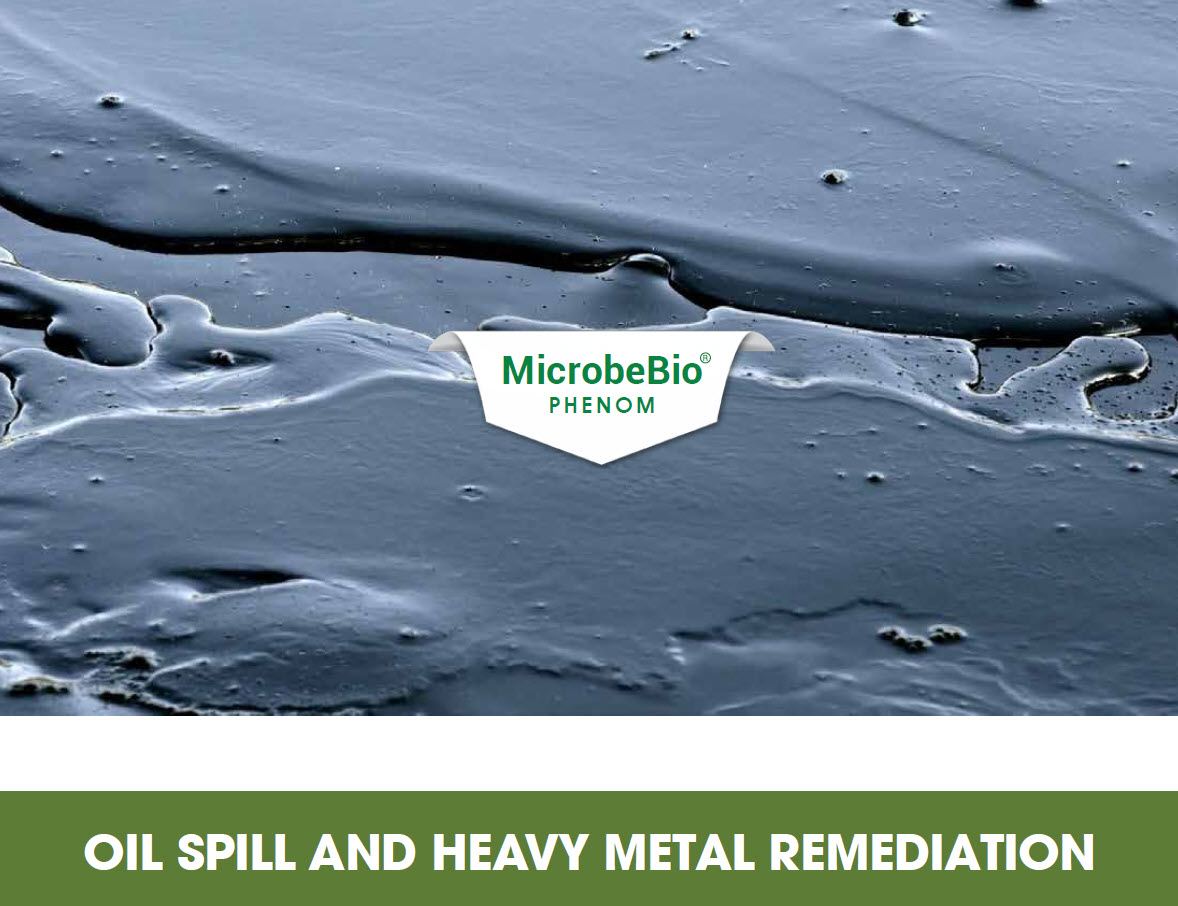
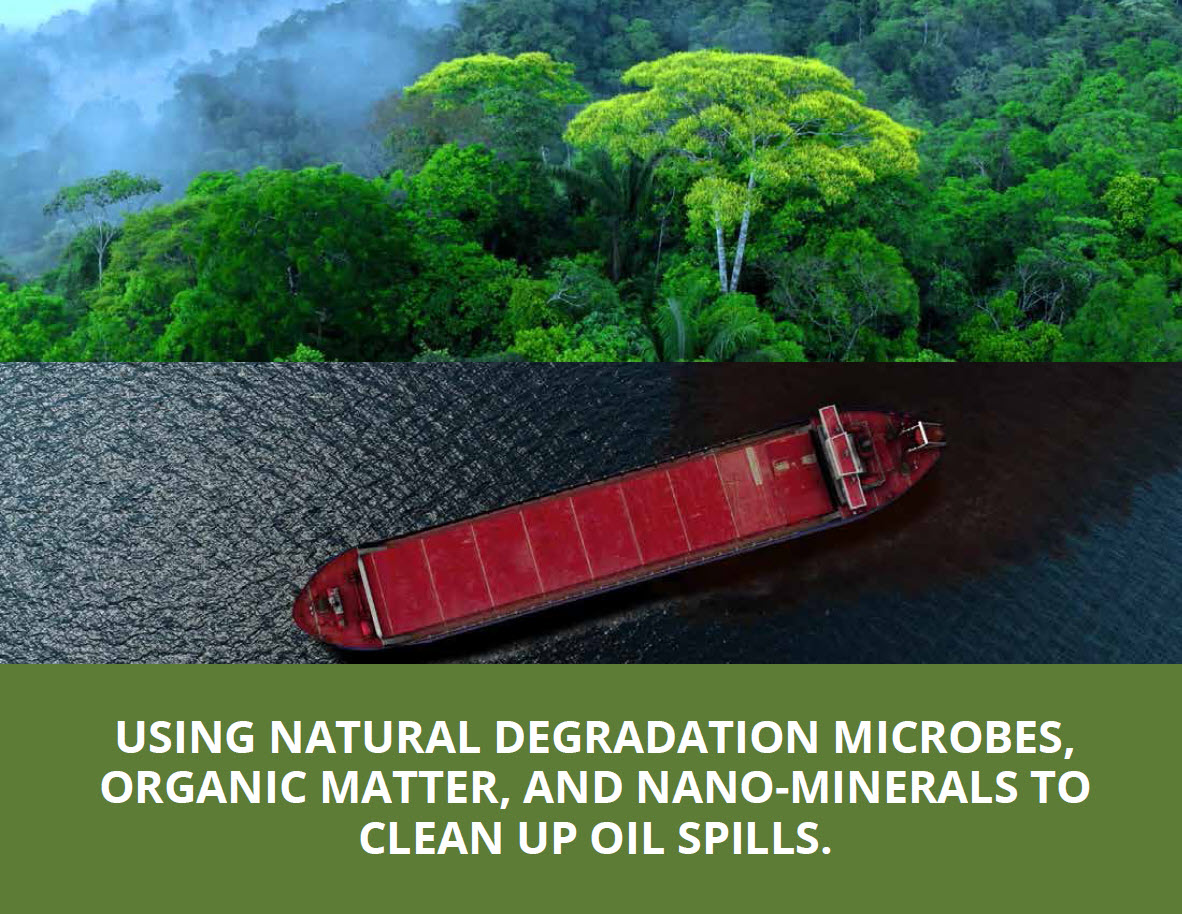
USING NATURAL
DEGRADATION
MICROBES,
ORGANIC
MATTER,
AND NANOMINERALS
TO
CLEAN UP OIL
SPILLS.
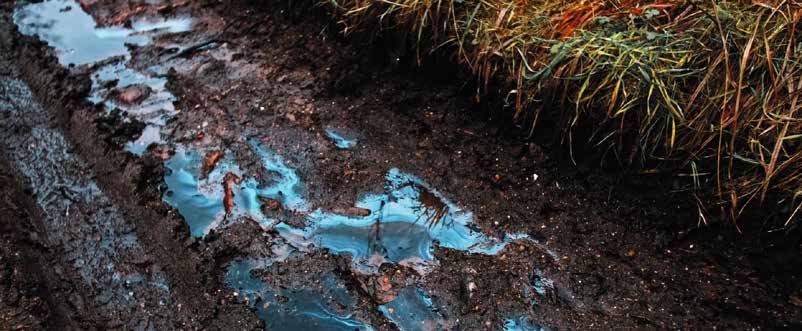
The best method of cleaning an oil spill depends on various factors, such as the location, size, and type of oil spill, as well as the environmental and economic impact of the cleanup effort. There is no one-size-fits-all solution, and a combination of methods is often used to achieve the most effective and efficient cleanup. Some of the most commonly used methods for cleaning oil spills include:
1. Skimming: This involves removing the oil from the surface of the water using boats equipped with special skimming devices.
2. Containment and recovery: This method involves using booms and other containment devices to prevent the spread of the oil, followed by pumping the oil from the water into storage tanks for later disposal.
3. Chemical dispersants are chemical agents sprayed onto the oil spill to break it down into smaller droplets, which natural processes can more easily degrade.
4. Mechanical removal involves using equipment such as excavators, bulldozers, and shovels to remove the oil from the shoreline and surrounding areas physically.
5. Natural degradation involves using naturally occurring bacteria and other microorganisms to break down the oil into harmless byproducts over time.
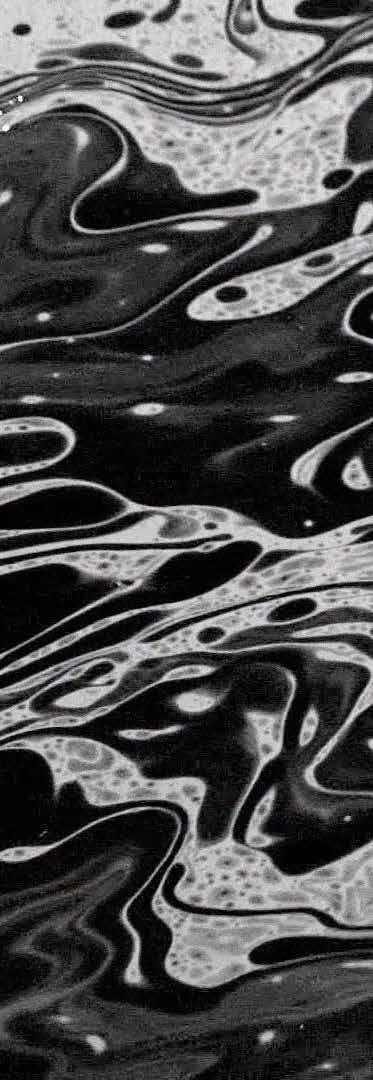
In practice, the most effective method of cleaning an oil spill will depend on the specific circumstances of the spill and the resources available for the cleanup effort. It is important to assess each method’s environmental impact carefully and choose the one most appropriate for the situation.
Oil spills can devastate the environment, so using natural degradation Microbebio microbes to clean them up is an appealing approach. Microbes can break down specific components of crude oil, such as alkanes and aromatic hydrocarbons, into harmless byproducts. This process is called bioremediation.
Petroleum is a heterogeneous mixture of hydrocarbons, including alicyclic, aliphatic, and aromatic varieties. These hydrocarbons vary in their physical and compositional properties depending on their source. They are organic compounds containing hydrogen and carbon and are insoluble in water.
Microbebio microorganisms can both produce and degrade hydrocarbons, depending on the metabolic pathways available to them. Anthropogenic activities, such as petroleum and petroleum derivative spills, incomplete combustion of fossil fuels, and industrial activities, have caused an accumulation of hydrocarbons in the environment. An oil spill has a significant ecological impact on both terrestrial and marine ecosystems.
Several processes, including volatilization, sorption, biotransformation, and chemical or photochemical transformation, determine the end destination of hydrocarbons in the environment. Volatisation and sorption are not destructive to the contaminants but can transport or accumulate them elsewhere. Abiotic chemical transformation processes are slow and often involve organic pollutants, while abiotic photochemical reactions have limited significance in most environments.
Natural degradation plays a vital role in the process of bioremediation. These solutions for crude oil remediation have genetic diversity that helps microorganisms to transform contaminants into lesser toxic end products. Microbebio microbes make it possible for compounds and biomass formation to be mineralized entirely, which is a primary advantage of these contaminant degrading processes. With that said, several factors influence the effectiveness of petroleum contaminant biodegradation, such as competitiveness, temperature salinity, and concentration levels, among others.
The high enzymatic capacity of Microbebio benefits microbes and allows them to degrade complex hydrocarbons like petroleum which ultimately leads to its decomposition or modification into less hazardous substances at an accelerated rate than what would happen naturally without their presence. Introducing these enzymes can also help increase the availability of nutrients needed for microbial growth while simultaneously providing access pathways within cells to break down pollutants more efficiently using metabolic activities like oxidation-reduction reactions (REDOX).
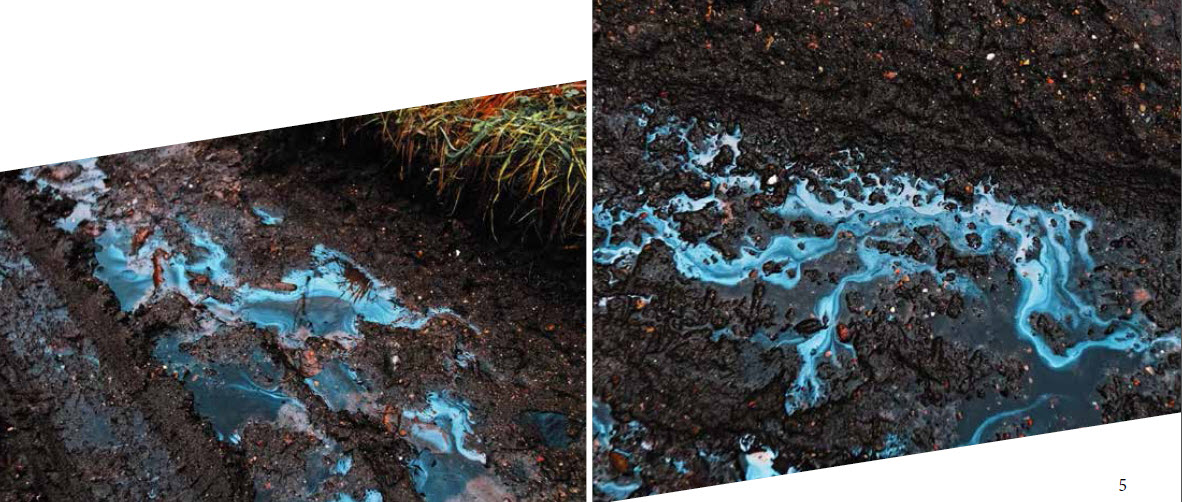
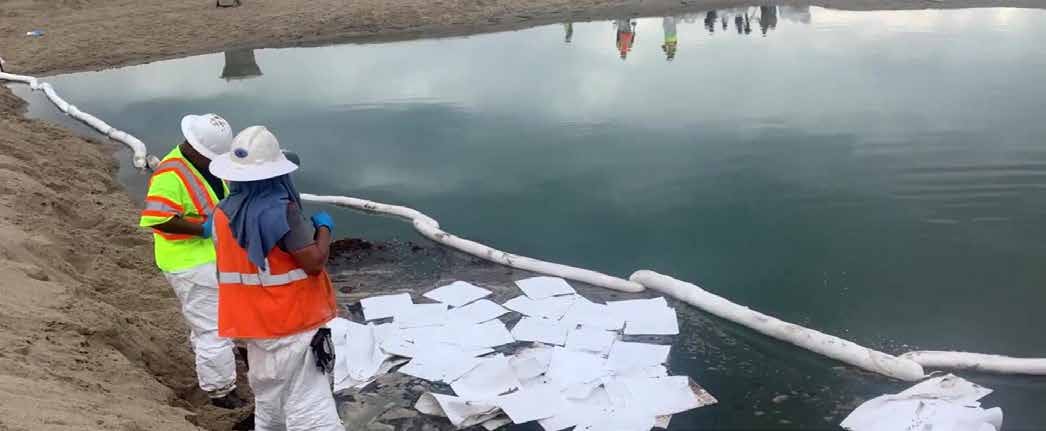
Overall, when combined with other methods such as physical removal, chemical treatment or application absorbance material, and Microbebio formula crude oil enzyme applications are essential tools used in environmental protection due to their ability to accelerate natural degradation processes and reduce risk from potential contamination sources faster than traditional methods alone could achieve on its own accord over time frame given available resources present at any given location where this kind application may need take place.
Microbebio Nanotechnology is a potential solution for cleaning up oil spills, using nanoparticles as adsorbents to remove oil from the water surface physically. Nanoparticles such as magnetic iron oxide (Fe3O4) and aluminum oxide (Al2O3) are effective at adsorbing oil and can be easily separated from the water using a magnetic field.

Another approach is to use Microbebio nanotechnology to enhance the biodegradation of oil. Specific nanoparticles, such as zinc oxide (ZnO) and titanium dioxide (TiO2), have been shown to have photocatalytic properties that can promote oil degradation by breaking down its molecular structure.
Using process hemp/kenaf as an absorbance and microbes to clean up oil spills is a promising approach. Hemp/kenaf is a fastgrowing plant that can absorb large amounts of pollutants from soil and water, including oil. Additionally, certain microbes, such as hydrocarbon-degrading bacteria, can break down the toxic compounds in oil into harmless byproducts.
It’s great to see that you are interested in using eco-friendly solutions to clean up oil spills. The use of hemp/kenaf and microbes is indeed a promising approach, as it combines the natural ability of the plant to absorb oil with the ability of the microbes to break down toxic compounds.
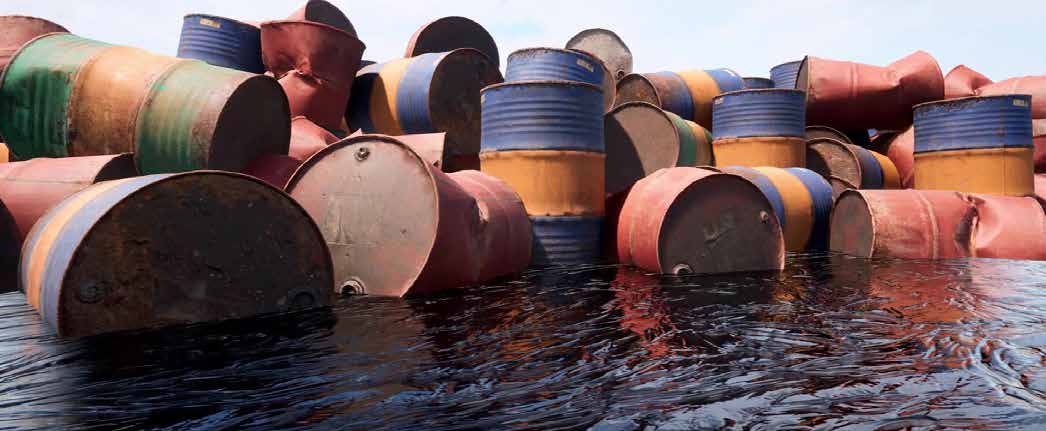
The potential benefits of using an eco-friendly solution for oil spill cleanup may make it worth the investment in the long term. It’s also important to consider the environmental benefits and the reduction of harm to wildlife and other ecosystems that can be achieved through this approach.
In any case, it’s encouraging to see efforts being made to find environmentally-friendly solutions for oil spill cleanup. The combination of natural absorbance and can be a game-changer in this field.
Compared to chemical treatments that could potentially damage it further.
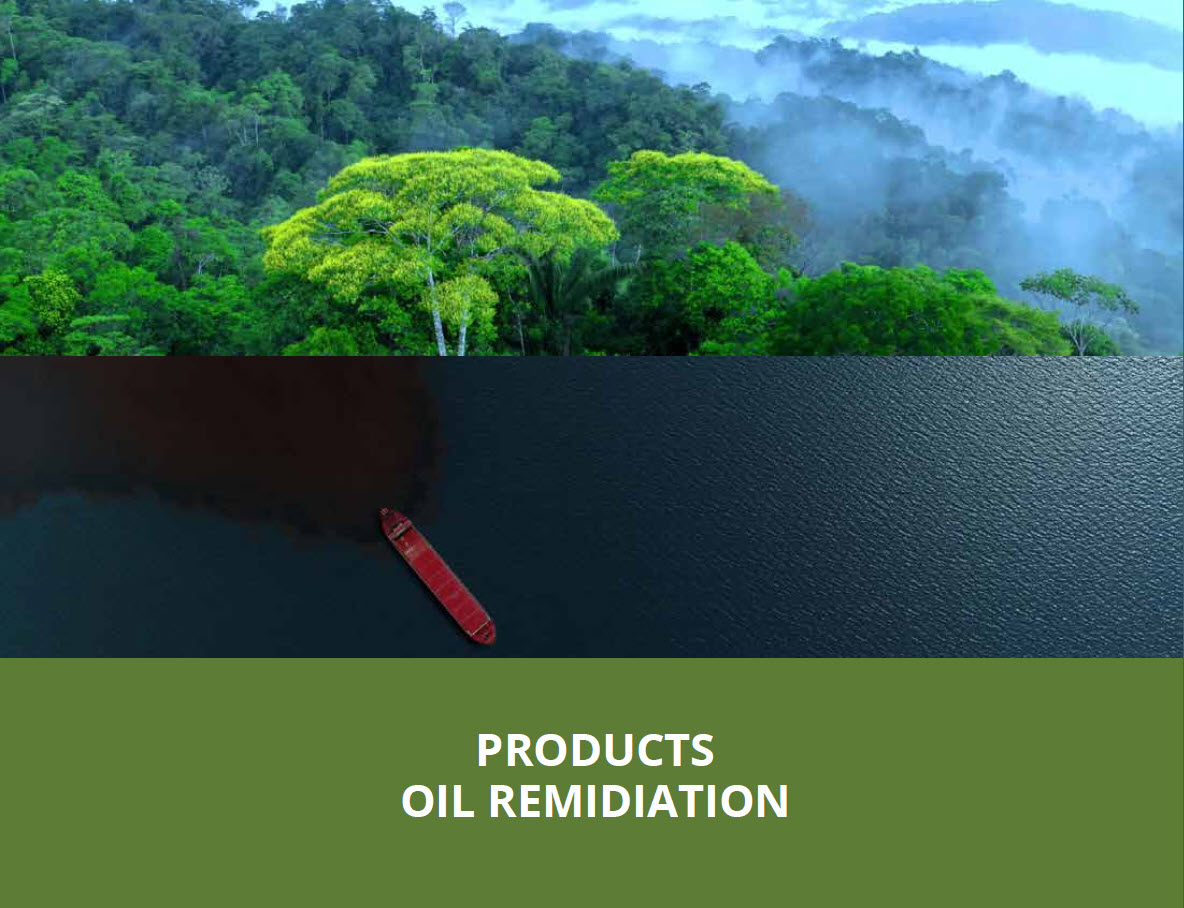
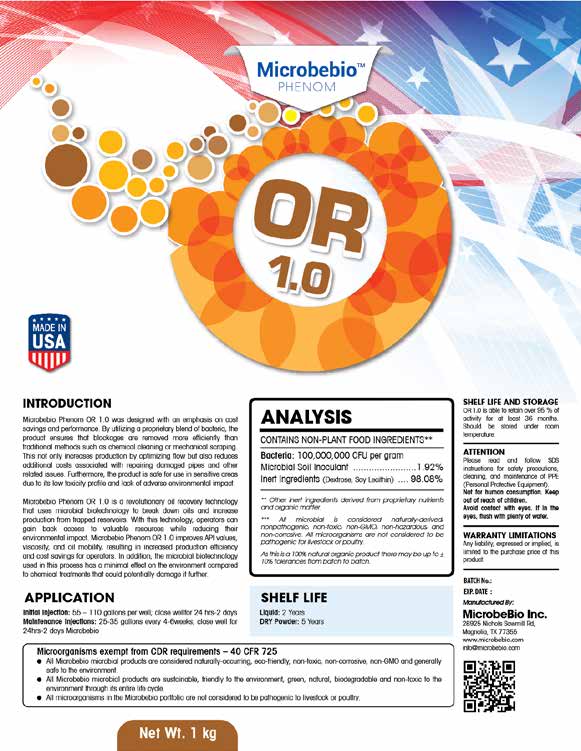
Microbebio Phenom OR 1.0
(Microbial Enhanced Oil Recovery Downhole Injection):
The Microbebio Phenom OR 1.0 was designed with an emphasis on cost savings and performance. By utilizing a proprietary blend of bacteria, the product ensures that blockages are removed more efficiently than traditional methods such as chemical cleaning or mechanical scraping. This not only increases production by optimizing flow but also reduces additional costs associated with repairing damaged pipes and other related issues. Furthermore, the product is safe for use in sensitive areas due to its low toxicity profile and lack of adverse environmental impact.
Microbebio Phenom OR 1.0 is a revolutionary oil recovery technology that uses microbial biotechnology to break down oils and increase production from trapped reservoirs. With this technology, operators can gain back access to valuable resources while reducing their environmental impact. Microbebio Phenom OR 1.0 improves API values, viscosity, and oil mobility, resulting in increased production efficiency and cost savings for operators. In addition, the microbial biotechnology used in this process has a minimal effect on the environment compared to chemical treatments that could potentially damage it further.
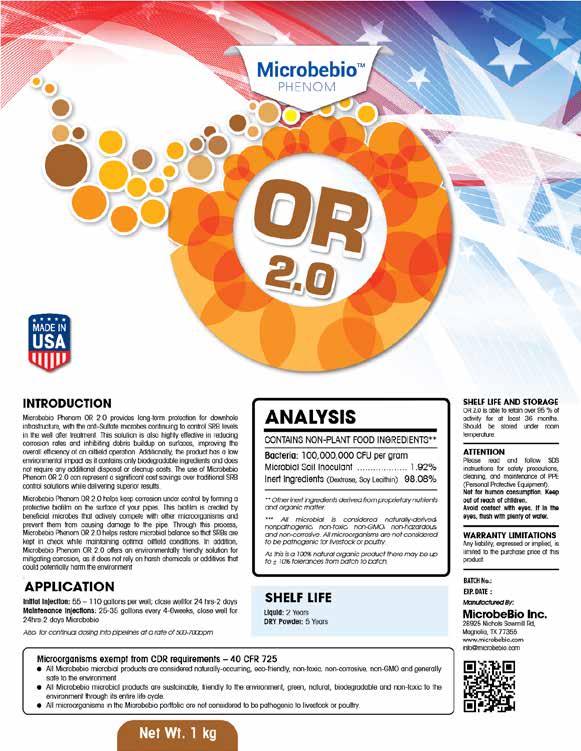
Microbebio Phenom OR 2.0
(SRB, H2S, and CO2 Corrosion Control)
Microbebio Phenom OR 2.0 provides long-term protection for downhole infrastructure, with the anti-Sulfate microbes continuing to control SRB levels in the well after treatment. This solution is also highly effective in reducing corrosion rates and inhibiting debris buildup on surfaces, improving the overall efficiency of an oilfield operation. Additionally, the product has a low environmental impact as it contains only biodegradable ingredients and does not require any additional disposal or cleanup costs. The use of Microbebio Phenom OR 2.0 can represent a significant cost saving over traditional SRB control solutions while delivering superior results.
Microbebio Phenom OR 2.0 helps keep corrosion under control by forming a protective biofilm on the surface of your pipes. This biofilm is created by beneficial microbes that actively compete with other microorganisms and prevent them from causing damage to the pipe. Through this process, Microbebio Phenom OR 2.0 helps restore microbial balance so that SRBs are kept in check while maintaining optimal oilfield conditions. In addition, Microbebio Phenom OR 2.0 offers an environmentally friendly solution for mitigating corrosion, as it does not rely on harsh chemicals or additives that could potentially harm the environment.
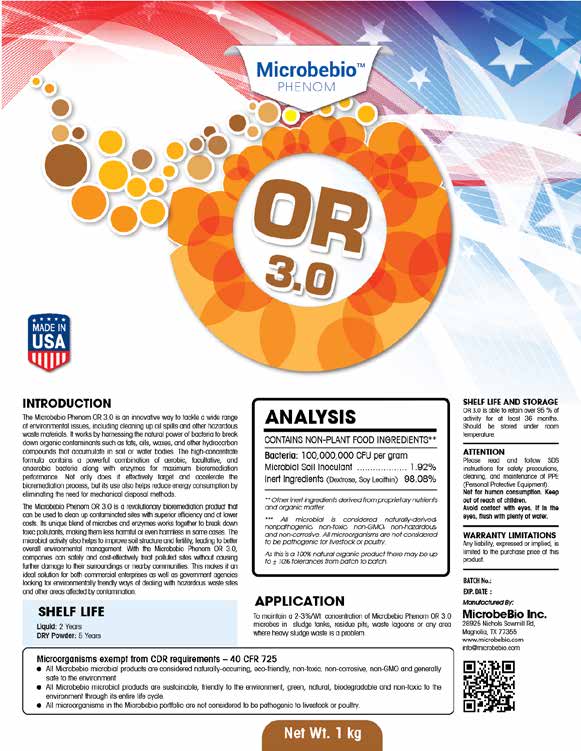
Microbebio Phenom OR 3.0
(Heavy Sludge, Wax, Chemical and Residue Bioremediation)
The Microbebio Phenom OR 3.0 is an innovative way to tackle a wide range of environmental issues, including cleaning up oil spills and other hazardous waste materials. It works by harnessing the natural power of bacteria to break down organic contaminants such as fats, oils, waxes, and other hydrocarbon compounds that accumulate in soil or water bodies. The high-concentrate formula contains a powerful combination of aerobic, facultative, and anaerobic bacteria along with enzymes for maximum bioremediation performance. Not only does it effectively target and accelerate the bioremediation process, but its use also helps reduce energy consumption by eliminating the need for mechanical disposal methods.
The Microbebio Phenom OR 3.0 is a revolutionary bioremediation product that can be used to clean up contaminated sites with superior efficiency and at lower costs. Its unique blend of microbes and enzymes works together to break down toxic pollutants, making them less harmful or even harmless in some cases. The microbial activity also helps to improve soil structure and fertility, leading to better overall environmental management. With the Microbebio Phenom OR 3.0, companies can safely and cost-effectively treat polluted sites without causing further damage to their surroundings or nearby communities. This makes it an ideal solution for both commercial enterprises as well as government agencies looking for environmentally friendly ways of dealing with hazardous waste sites and other areas affected by contamination.
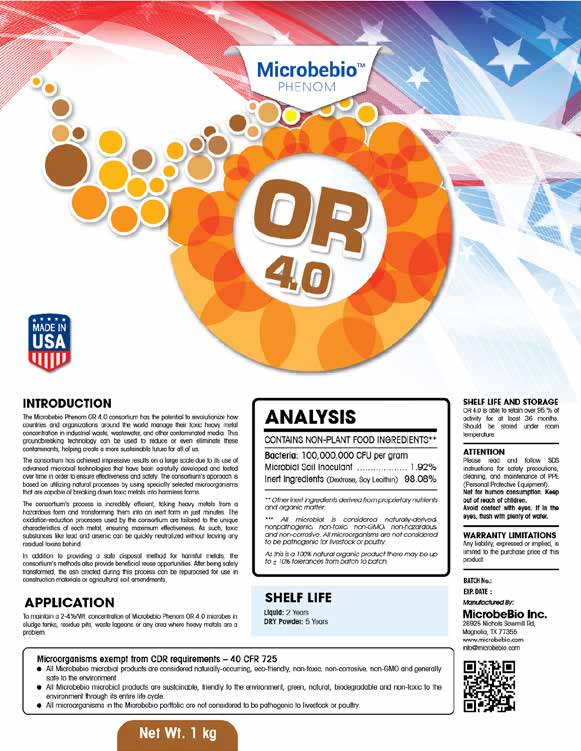
Microbebio Phenom OR 4.0
The Microbebio Phenom OR 4.0 consortium has the potential to revolutionize how countries and organizations around the world manage their toxic heavy metal concentration in industrial waste, wastewater, and other contaminated media. This groundbreaking technology can be used to reduce or even eliminate these contaminants, helping create a more sustainable future for all of us.
The consortium has achieved impressive results on a large scale due to its use of advanced microbial technologies that have been carefully developed and tested over time in order to ensure effectiveness and safety. The consortium’s approach is based on utilizing natural processes by using specially selected microorganisms that are capable of breaking down toxic metals into harmless forms.
The consortium’s process is incredibly efficient, taking heavy metals from a hazardous form and transforming them into an inert form in just minutes. The oxidation-reduction processes used by the consortium are tailored to the unique characteristics of each metal, ensuring maximum effectiveness. As such, toxic substances like lead and arsenic can be quickly neutralized without leaving any residual toxins behind.
In addition to providing a safe disposal method for harmful metals, the consortium’s methods also provide beneficial reuse opportunities. After being safely transformed, the ash created during this process can be repurposed for use in construction materials or agricultural soil amendments.
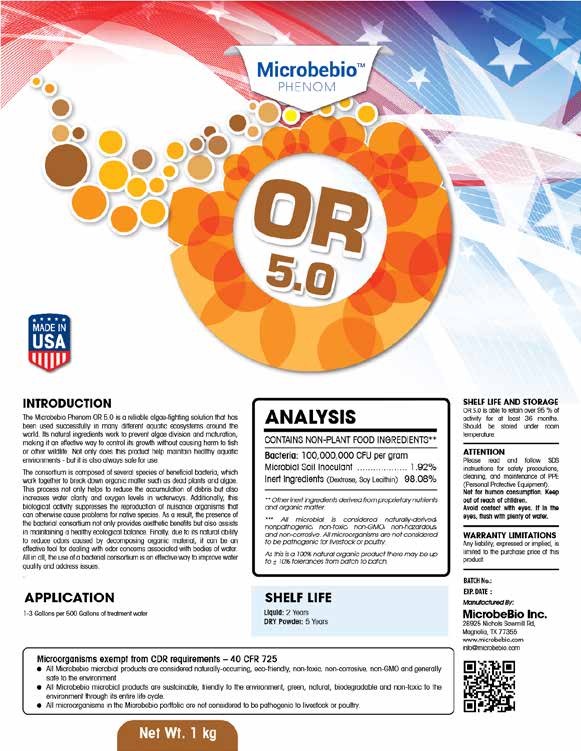
Microbebio Phenom OR 5.0
The Microbebio Phenom OR 5.0 is a reliable algae-fighting solution that has been used successfully in many different aquatic ecosystems around the world. Its natural ingredients work to prevent algae division and maturation, making it an effective way to control its growth without causing harm to fish or other wildlife. Not only does this product help maintain healthy aquatic environments – but it is also always safe for use.
The consortium is composed of several species of beneficial bacteria, which work together to break down organic matter such as dead plants and algae. This process not only helps to reduce the accumulation of debris but also increases water clarity and oxygen levels in waterways. Additionally, this biological activity suppresses the reproduction of nuisance organisms that can otherwise cause problems for native species. As a result, the presence of the bacterial consortium not only provides aesthetic benefits but also assists in maintaining a healthy ecological balance. Finally, due to its natural ability to reduce odors caused by decomposing organic material, it can be an effective tool for dealing with odor concerns associated with bodies of water. All in all, the use of a bacterial consortium is an effective way to improve water quality and address issues
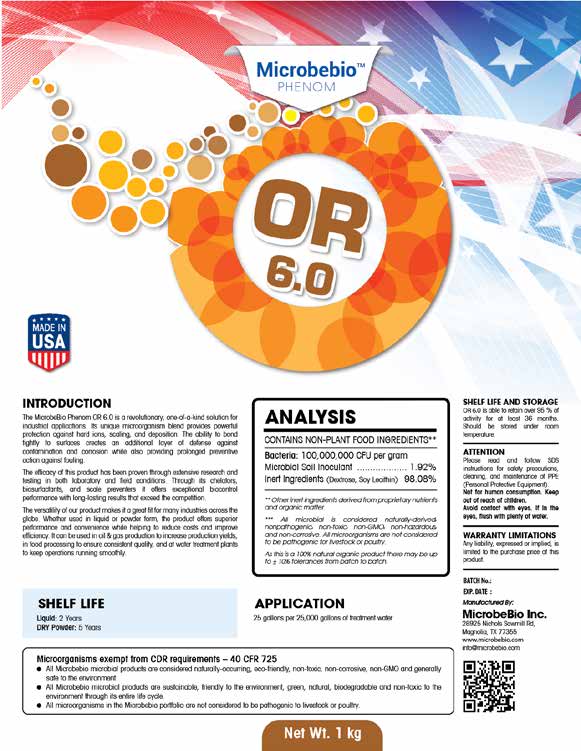
Microbebio Phenom OR 6.0
The MicrobeBio Phenom OR 6.0 is a revolutionary, one-of-a-kind solution for industrial applications. Its unique microorganism blend provides powerful protection against hard ions, scaling, and deposition. The ability to bond tightly to surfaces creates an additional layer of defense against contamination and corrosion while also providing prolonged preventive action against fouling.
The efficacy of this product has been proven through extensive research and testing in both laboratory and field conditions. Through its chelators, biosurfactants, and scale preventers it offers exceptional biocontrol performance with long-lasting results that exceed the competition. The versatility of our product makes it a great fit for many industries across the globe. Whether used in liquid or powder form, the product offers superior performance and convenience while helping to reduce costs and improve efficiency. It can be used in oil & gas production to increase production yields, in food processing to ensure consistent quality, and at water treatment plants to keep operations running smoothly.
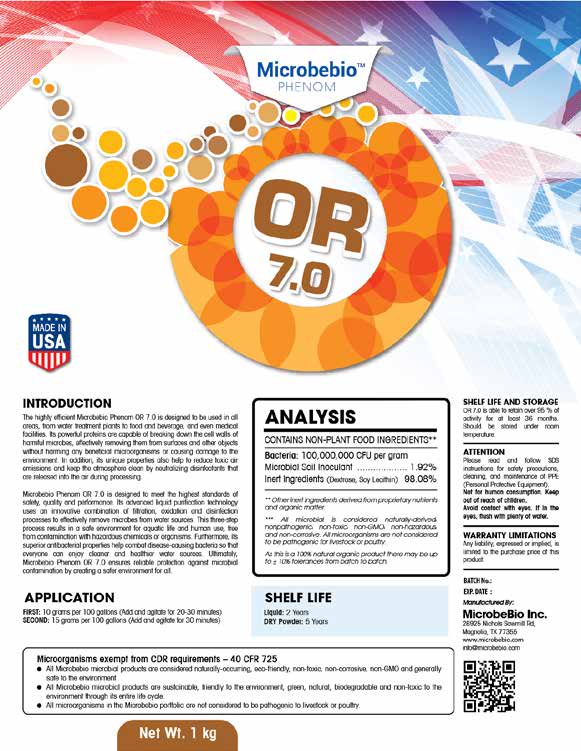
Microbebio Phenom OR 7.0
The highly efficient Microbebio Phenom OR 7.0 is designed to be used in all areas, from water treatment plants to food and beverage, and even medical facilities. Its powerful proteins are capable of breaking down the cell walls of harmful microbes, effectively removing them from surfaces and other objects without harming any beneficial microorganisms or causing damage to the environment. In addition, its unique properties also help to reduce toxic air emissions and keep the atmosphere clean by neutralizing disinfectants that are released into the air during processing.
Microbebio Phenom OR 7.0 is designed to meet the highest standards of safety, quality, and performance. Its advanced liquid purification technology uses an innovative combination of filtration, oxidation, and disinfection processes to effectively remove microbes from water sources. This three-step process results in a safe environment for aquatic life and human use, free from contamination with hazardous chemicals or organisms. Furthermore, its superior antibacterial properties help combat disease-causing bacteria so that everyone can enjoy cleaner and healthier water sources. Ultimately, Microbebio Phenom OR 7.0 ensures reliable protection against microbial contamination by creating a safer environment for all.
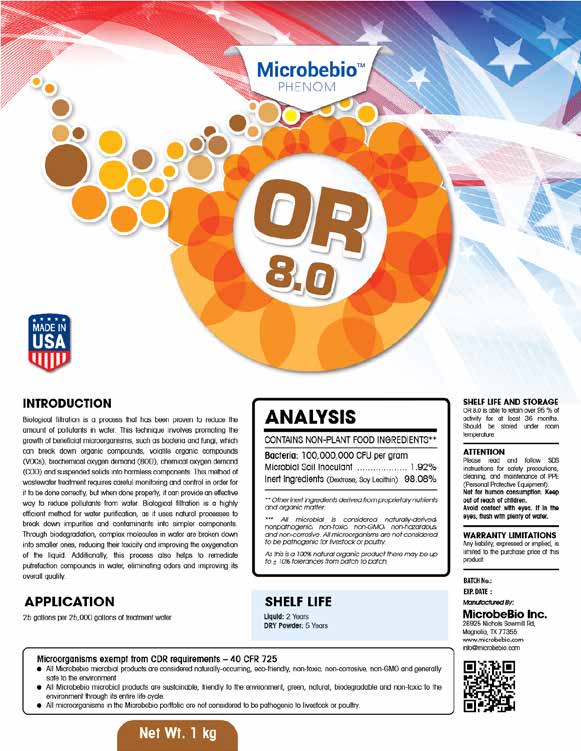
Microbebio Phenom OR 8.0
Biological filtration is a process that has been proven to reduce the number of pollutants in water. This technique involves promoting the growth of beneficial microorganisms, such as bacteria and fungi, which can break down organic compounds, volatile organic compounds (VOCs), biochemical oxygen demand (BOD), chemical oxygen demand (COD), and suspended solids into harmless components. This method of wastewater treatment requires careful monitoring and control in order for it to be done correctly, but when done properly, it can provide an effective way to reduce pollutants from water. Biological filtration is a highly efficient method for water purification, as it uses natural processes to break down impurities and contaminants into simpler components. Through biodegradation, complex molecules in water are broken down into smaller ones, reducing their toxicity and improving the oxygenation of the liquid. Additionally, this process also helps to remediate putrefaction compounds in water, eliminating odors and improving its overall quality.
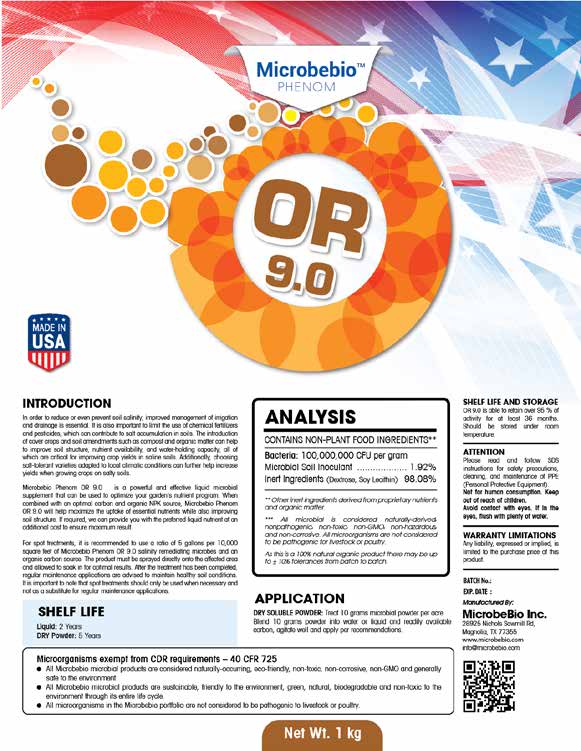
Microbebio Phenom OR 9.0
In order to reduce or even prevent soil salinity, improved management of irrigation and drainage is essential. It is also important to limit the use of chemical fertilizers and pesticides, which can contribute to salt accumulation in soils. The introduction of cover crops and soil amendments such as compost and organic matter can help to improve soil structure, nutrient availability, and water-holding capacity; all of which are critical for improving crop yields in saline soils.
Additionally, choosing salt-tolerant varieties adapted to local climatic conditions can further help increase yields when growing crops on salty soils. Microbebio Phenom OR 9.0 is a powerful and effective liquid microbial supplement that can be used to optimize your garden’s nutrient program. When combined with an optimal carbon and organic NPK source, Microbebio Phenom OR 9.0 will help maximize the uptake of essential nutrients while also improving soil structure. If required, we can provide you with the preferred liquid nutrient at an additional cost to ensure maximum results.
For spot treatments, it is recommended to use a ratio of 5 gallons per 10,000 square feet of Microbebio Phenom OR 9.0 salinity remediating microbes and an organic carbon source. The product must be sprayed directly onto the affected area and allowed to soak in for optimal results. After the treatment has been completed, regular maintenance applications are advised to maintain healthy soil conditions. It is important to note that spot treatments should only be used when necessary and not as a substitute for regular maintenance applications.